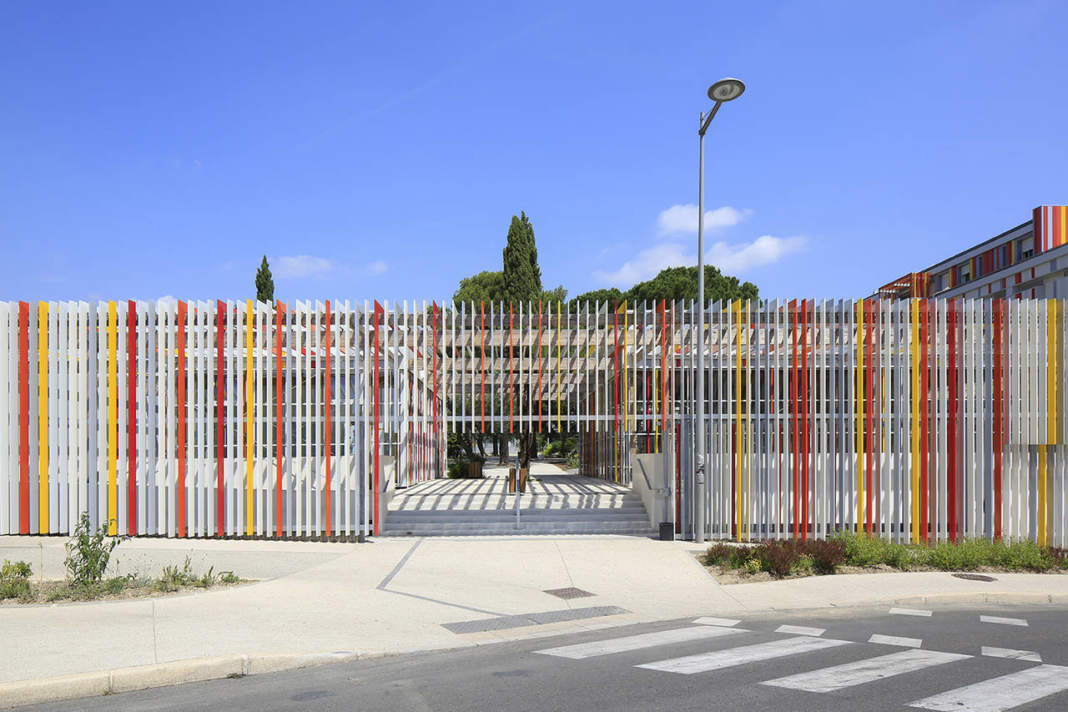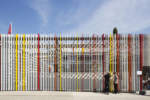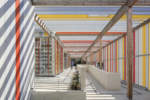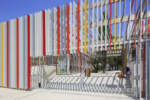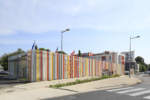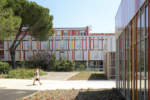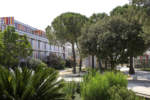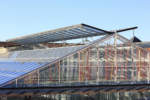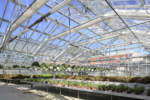The principal idea in the site of the high school Honoré de Balzac de Castelnau-le-Lez was to reconquer space by a better distribution of constructions in order to create a scale of user-friendliness as well in the buildings as in the outdoor areas. The first action was to reconsider the current landscape, to bring a functionality to external installations thus conveying true space qualities and to create a total logic of circulation within the site. The constitution of this new urbanity becomes the base of a shared and porous space, generator of exchanges comparable with the strategic constitution of a campus. The nature becomes the vector of a new contemporary urbanity organized around inter-connected buildings.
One of the challenges of this project was the establishment of a work pushed on the concept of filter. High vertical and successive breezes sun break up space and offer variations of shade and light. A right measurement of the transparency makes possible the game of what is hidden, of what is seen, thus breaking up space into various layers for walkers within the establishment.
It was also necessary to open the site by offering a reconstituted principal access to him and displaying a strong and contemporary identity as of the principal access on the public pathway. The entrance, crossing point important becomes an accessible threshold with the undeniable contemporary aspect. It confers a new image on the high school, anchored in its local fabric, project in a durable future. A work on the color offers a luminous framework of teaching and created a total unit thanks to the facades.
Within the boundary of this high school, it is a true ecosystem which is created. The vegetable mass, by its density and the including shade that it gets, essential in a Mediterranean climate being able to reach strong temperatures, contributes to this specific environment relative to an organization programming science combining rooms of teaching theoretical and places of practices which they are a horticultural greenhouse or a bird selling.
The greenhouses of this agricultural college needed to have a central position from their paramount function for a high school professional. Indeed, they are the place of the first experiments making it possible to the pupils to be under real conditions of activity. The ideal climate within the greenhouses ensures a floral production throughout the year and thus allow them to fully play their part directly related to the pedagogy of the establishment. The greenhouses of this high school are the place of the representation of a “know to learn” and one “how to teach”, thus displaying an ethical posture desired by the establishment.
After more than ten years of close collaboration, Elodie Nourrigat, Jacques Brion and Romain Jamot architects have created the agency NBJ in 2013 in Montpellier. This comes from the combination of two structures, N+B Architects, which was founded by Elodie Nourrigat and Jacques Brion in 2000 and Romain Jamot Architects, established in 2003. All three are graduates of the Ecole Nationale Superieure d'Architecture de Montpellier (ENSAM) and Elodie Nourrigat and Jacques Brion obtained in 2002 a Master of Philosophy degree. Elodie Nourrigat has obtained in 2011 a PhD in Architecture. They are also teachers at the Ecole Nationale Superieure d'Architecture de Montpellier (ENSAM). The current structure of the agency brings a structured team of professionals with expertise in architecture, urban planning, sustainable environmental issues and engaging in programs to explore new way of project development. Their projects join different scales, whether architectural or urban.Their work has been recognized through various awards. In September 2008, they were invited to the 11th Architectural Biennale in Venice in the French Pavilion. The same year, they were awarded by the prize “Europe 40 under 40”, price distinguishing the top 40 agencies under 40 years in Europe. The project of the Activity Park of Camalcé in Gignac, was distinguished by the " International Award 2009 " price, attributed by the Chicago Athenaeum Museum. They carry their education abroad, whether is at Laval University in Quebec City (Canada), RMIT in Melbourne (Australia), Tohoku University in Sendai (Japan), College of Design at the University of Kentucky (USA) . Invested in the dissemination of architecture culture, they create and organize since 2006, the Festival Architecture Vives, which invites young architects to intervene in the courtyards of mansions in Montpellier city and in the city of La Grande Motte.


